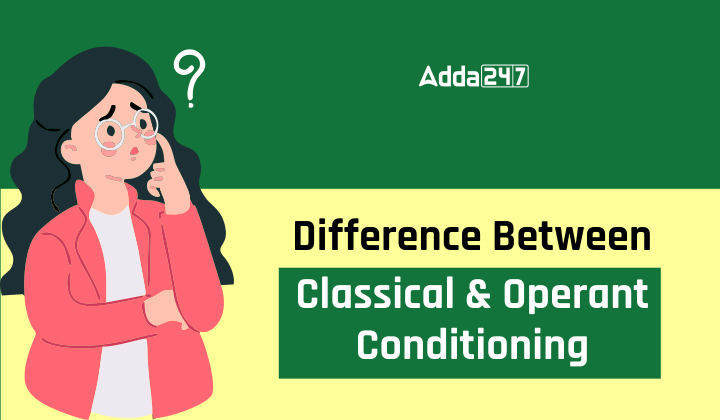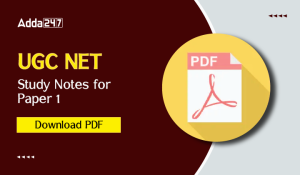Table of Contents
Operant and Classical Conditioning are fundamental learning theories often featured in the Child Development and Pedagogy (CDP) section of competitive teaching exams like UGC NET, CTET, HTET, KVS and others. These topics usually carry 2-3 marks and are considered high-scoring if understood clearly. Classical Conditioning, first explored by Ivan Pavlov through experiments with dogs, explains how learning occurs through associations between stimuli. In contrast, Operant Conditioning, introduced by B.F. Skinner using reward-based experiments with mice, focuses on learning through consequences- reinforcement or punishment. Knowing the key differences between these two conditioning methods, along with relevant examples, helps candidates strengthen their grasp of the learning chapter and score better in exams.
What is the Classical Conditioning?
Classical Conditioning is a type of learning in which an organism learns to associate one stimulus with another, leading to a learned response. First studied by Ivan Pavlov during his research on digestion in dogs, this learning process involves pairing a neutral stimulus (like the sound of a bell) with an unconditioned stimulus (such as food) that naturally triggers an unconditioned response (like salivation). Over time, the neutral stimulus becomes a conditioned stimulus (CS) and elicits a conditioned response (CR)- in this case, salivation- even in the absence of food. This anticipatory learning helps the organism prepare for events and adapt behavior based on associations.
What is the Operant Conditioning?
Operant Conditioning is a learning process where the consequences of a behavior determine its future occurrence. Introduced by B.F. Skinner, this type of learning involves voluntary responses called operants that are either strengthened or weakened depending on the outcome that follows. If a behavior is followed by a reinforcer (like praise or a reward), it’s more likely to happen again. Conversely, if it’s followed by a punishment or no reinforcement, it becomes less frequent. The effectiveness of operant conditioning depends on factors such as the type of reinforcement, how often it’s given (schedule), and how quickly it’s delivered after the response.
Difference Between Operant and Classical Conditioning
We can divide the differences between classical and instrumental or operant conditions into the following two categories:
- Procedural Differences.
- Theoretical Differences.
हम प्राचीन और नैमित्तिक या क्रियाप्रसूत अनुबंधन के बीच के अंतर को निम्नलिखित दो श्रेणियों में विभाजित कर सकते हैं:
- प्रक्रियात्मक अंतर
- सैद्धांतिक अंतर
- Procedural Differences: These types of differences occur due to the difference in manipulating the relationships of stimuli, responses and reinforcement. प्रक्रियात्मक अंतर: उत्तेजनाओं, प्रतिक्रियाओं और प्रबलन के संबंधों में हेरफेर करने के अंतर के कारण इस प्रकार के अंतर होते हैं
(i) Contingency of Responses and Results: In instrumental or operant responses, the responses & the results of responses depend mutually, while in classical conditioning, this contingency exists between conditioned stimulus (CS) and Unconditioned Stimulus (US).
जवाब और परिणामों की आकस्मिकता : नैमित्तिक या क्रियाप्रसूत प्रतिक्रियाओं में, प्रतिक्रियाओं और प्रतिक्रियाओं के परिणाम परस्पर निर्भर करते हैं, जबकि प्राचीन अनुबंधन में, यह आकस्मिकता सशर्त उत्तेजना (सीएस) और बिना शर्त उत्तेजना (यूएस) के बीच मौजूद है।
(ii) Clarity of Stimuli : Classical conditioning possesses identifiable CS & US, which in instrumental or operant conditioning, no stimulus can be identified or recognized. उत्तेजना की स्पष्टता:
प्राचीन अनुबंधन के पास पहचान योग्य CS और US होते हैं, जिसमें कि नैमित्तिक या क्रियाप्रसूत अनुबंधन में, किसी भी उत्तेजना को पहचाना या पहचाना नहीं जा सकता है.
(iii) Role of Reinforcement: In classical conditioning, US functions as reinforcement because without it conditioning is not possible. In instrumental or operant conditioning, reinforcement is provided to some definite or determined response.
प्रबलन की भूमिका: प्राचीन अनुबंधन में, यूएस सुदृढीकरण के रूप में कार्य करता है क्योंकि इसके बिना अनुबंधन संभव नहीं है। नैमित्तिक या क्रियाप्रसूत अनुबंधन में, कुछ निश्चित या निर्धारित प्रतिक्रिया के लिए प्रबलन प्रदान किया जाता है
(iv) Experimenter’s Control Over Response: In classical conditioning, that response is under the control of the experimenter which he wants to condition. He can produce that response which he wants to condition by providing the US to the subject as and when he wishes. Contrary to this in instrumental conditioning, the experimenter has no such stimulus by which he can get a response.
प्रतिक्रिया पर प्रायोगिक नियंत्रण: प्राचीन अनुबंधन में, वह प्रतिक्रिया प्रयोगकर्ता के नियंत्रण में होती है जिसे वह अनुबंध करना चाहता है। वह उस प्रतिक्रिया को उत्पन्न कर सकता है जिसे वह अपनी इच्छानुसार अमेरिका को इस विषय पर उपलब्ध कराना चाहता है। नैमित्तिक अनुबंधन में इसके विपरीत, प्रयोग करने वाले के पास ऐसी कोई उत्तेजना नहीं होती है जिसके द्वारा वह प्रतिक्रिया प्राप्त कर सकता है।
(v) Response Type: It has been proved by various studies that only classical conditioning processes can study autonomic responses, such as saliva secretion. But in instrumental conditioning or operant conditioning, only the responses related to the nervous system can be conditioned.
प्रतिक्रिया प्रकार: विभिन्न अध्ययनों से यह साबित हुआ है कि केवल प्राचीन अनुबंधन प्रक्रियाएं स्वायत्त प्रतिक्रियाओं का अध्ययन कर सकती हैं, जैसे लार का स्राव। लेकिन नैमित्तिक या क्रियाप्रसूत अनुबंधन में, केवल तंत्रिका तंत्र से संबंधित प्रतिक्रियाओं को वातानुकूलित किया जा सकता है।
- Theoretical Differences: Thorndike has given the name to this phenomenon as learning by Trail and Error. From this point of view, classical conditioning is of S – S type and instrumental or operant conditioning is of S – R type conditioning. Both of these conditions are for two types of learning.
सैद्धांतिक अंतर: थार्नडाइक ने इस घटना को अधिगम के प्रयास व भूल का नाम दिया है। इस दृष्टि से, प्राचीन अनुबंधन S – S प्रकार की है और नैमित्तिक या क्रियाप्रसूत अनुबंधन S – R प्रकार की है। ये दोनों ही अनुबंधन दो प्रकार के हैं
According to Skinner, in classical conditioning, the reinforcement is related to excitement, while in instrumental conditioning, there is a positive relationship between response and reinforcement. The reinforcement to instrumental conditioning depends on the type of response a subject produces.
स्किनर के अनुसार, प्राचीन अनुबंधन में, प्रबलन उत्तेजना से संबंधित है, जबकि नैमित्तिक अनुबंधन में, एक प्रतिक्रिया और प्रबलन के बीच एक सकारात्मक संबंध है। नैमित्तिक अनुबंधन के लिए प्रबलन एक विषय द्वारा उत्पन्न प्रतिक्रिया के प्रकार पर निर्भर करता है
Difference between Classical Conditioning Theory and Operant Conditioning Theory
प्राचीन अनुबंधन सिद्धांत और क्रियाप्रसूत अनुबंधन सिद्धांत के बीच अंतर
| S. No. | Classical Conditioning Theory / प्राचीन अनुबंधन सिद्धांत | Operant Conditioning Theory /क्रियाप्रसूत अनुबंधन सिद्धांत |
| 1 | This theory was propounded by IVAN P. Pavlov a Russian Physiologist in 1903.
इस सिद्धांत को 1903 में एक रूसी फिजियोलॉजिस्ट आईवीएन पी पावलोव द्वारा प्रस्तावित किया गया था |
This theory was propounded by B. F. Skinner, an American Psychologist, in 1938.
इस सिद्धांत को 1938 में अमेरिकी मनोवैज्ञानिक, बी एफ स्किनर द्वारा प्रस्तावित किया गया था |
| 2 | In this kind of conditioning the behaviour is affected by the stimulus.
इस तरह के अनुबंधन में व्यवहार उत्तेजना से प्रभावित होता है |
In this kind of conditioning the behaviour is free restraints.
इस तरह के अनुबंधन में व्यवहार मुक्त प्रतिबंध है |
| 3 | In this kind of the conditioning the organism is not rewarded for every attempt (trail)
इस तरह के अनुबंधन में जीव को हर प्रयास (निशान) के लिए पुरस्कृत नहीं किया जाता है |
In this kind of conditioning the organism is rewarded for each successful attempt.
इस तरह के अनुबंधन में प्रत्येक सफल प्रयास के लिए जीव को पुरस्कृत किया जाता है |
| 4 | In this kind of conditioning the link between the stimulus and Response is based on the law of Proximity.
इस तरह के अनुबंधन में उत्तेजना और प्रतिक्रिया के बीच की कड़ी निकटता के नियम पर आधारित होती है |
In this kind of conditioning the relationship between the stimulus and the response is based on the law of effect.
इस तरह के अनुबंधन में उत्तेजना और प्रतिक्रिया के बीच संबंध प्रभाव के नियम पर आधारित होता है। |
| 5 | In this kind of conditioning the behaviour of the organism is controlled by Automatic Nervous System.
इस तरह के अनुबंधन में जीव का व्यवहार ऑटोमैटिक नर्वस सिस्टम द्वारा नियंत्रित होता है। |
In this kind of conditioning the behaviour of the organism is controlled by the Central Nervous System.
इस तरह के अनुबंधन में जीव का व्यवहार सेंट्रल नर्वस सिस्टम द्वारा नियंत्रित होता है। |
| 6 | In this kind of conditioning the organism exhibits its inner behaviour.
इस तरह की अनुबंधन में जीव अपने आंतरिक व्यवहार को प्रदर्शित करता है |
In this kind of conditioning the external behaviour of the organism is exhibited.
इस तरह के अनुबंधन में जीव के बाहरी व्यवहार को प्रदर्शित किया जाता है। |
| 7 | In this kind of conditioning the organism remains passive.
इस तरह की अनुबंधन में जीव निष्क्रिय रहता है |
In this kind of conditioning the organism remains active and to be rewarded it must act.
इस तरह के अनुबंधन में जीव सक्रिय रहता है और पुरस्कृत होने के लिए उसे कार्य करना चाहिए। |
| 8 | In this kind of conditioning two stimuli are presented simultaneously. When one of stimuli is removed after sometime the organism responds to the stimulus present.
इस तरह की अनुबंधन में दो उत्तेजनाओं को एक साथ प्रस्तुत किया जाता है। जब उत्तेजनाओं में से एक को हटा दिया जाता है तो कुछ समय बाद जीव उपस्थित उत्तेजनाओं के प्रति प्रतिक्रिया करता है। |
In this kind of conditioning two stimuli are presented simultaneously.
इस तरह के अनुबंधन में दो उत्तेजनाओं को एक साथ प्रस्तुत किया जाता है। |
| 9 | In this kind of conditioning the reinforcement (the reward) is offered to the dog before it begins to salivate.
इस तरह के अनुबंधन में कुत्ते को लार निकालने से पहले प्रबलन (पुरूस्कार) दिया जाता है |
In this kind of conditioning the rat acts before it gets the reward.
इस तरह के अनुबंधन में चूहे इनाम पाने से पहले ही काम कर लेते हैं |
| 10 | In this kind of conditioning the organism shows respondent behaviour. This kind of behaviour shows in response to a stimulus. Pavlov has used the term ‘elicited’ behaviour.
इस तरह के अनुबंधन में जीव प्रतिक्रियाशील व्यवहार दिखाता है। एक उत्तेजना के जवाब में इस तरह का व्यवहार दर्शाता है। पावलोव ने “एलिकेटेड” शब्द का प्रयोग किया है |
The behaviour in this kind of conditioning is operant behaviour. The operant behaviour as propounded by Skinner is ‘emitted’ behaviour.
इस तरह के अनुबंधन में व्यवहार का क्रियाप्र्सूत होता है। स्किनर द्वारा प्रतिपादित व्यवहार व्यवहार ’उत्सर्जित’ व्यवहार है |
| 11 | This kind of conditioning is stimulus based conditioning.
इस तरह का अनुबंधन उत्तेजना आधारित अनुबंधन है। |
This kind of conditioning is respondent behaviour.
इस तरह के अनुबंधन प्रतिक्रियाशील व्यवहार है। |
| 12 | In this kind of conditioning there is an associative relation between the two stimuli.
इस तरह के अनुबंधन में दोनों उत्तेजनाओं के बीच एक साहचर्य संबंध होता है। |
In this kind of conditioning there is an associative link between the stimulus and the response.
इस तरह के अनुबंधन में उत्तेजना और प्रतिक्रिया के बीच एक सहयोगी लिंक होता है. |
Difference Between Classical and Operant Conditioning PDF Notes
Candidates preparing for Teaching Exams can easily access the Difference Between Classical and Operant Conditioning Notes PDF file from the link provided below. They can refer to the PDF as a reference during preparation and most importantly during revisions.




 UGC NET Study Notes for Paper 1, Downloa...
UGC NET Study Notes for Paper 1, Downloa...
 GSET Teaching Aptitude Questions and Ans...
GSET Teaching Aptitude Questions and Ans...
 समुद्र का पर्य�...
समुद्र का पर्य�...












